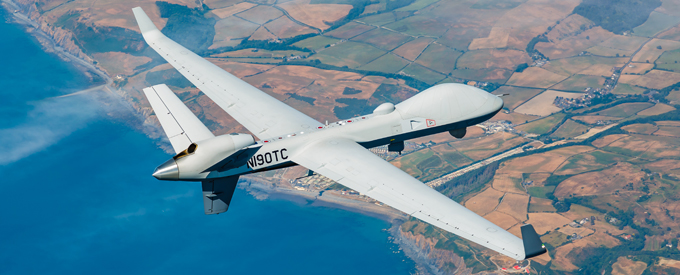2020-03-01
GA-ASI: Setting Global Trends Towards Integration of Large RPA into Non-Segregated Airspace
Remotely Pilot Aircraft Systems (RPAS) have historically been used for military applications and as military systems, designers and operators have generally not considered the application of Communication, Navigation, Surveillance (CNS) and Air Traffic Management (ATM) systems and capabilities for use in non-segregated airspace. This is especially true for large RPA, which operate in the same airspace as civilian aircraft, and has led to a prolonged and difficult effort to safely and seamlessly integrate these aircraft in the airspace above many countries with advanced ATM Systems.
In order to understand how such a unified Air Traffic Management System (ATMS) will work with RPAS, the U.S. Federal Aviation Administration (FAA) has initiated various small steps to introduce a separate but dependent RPAS traffic management system, which operates under the same ecosystem of regular ATMS. Areas of focus include concept and use case development, data exchange and information architecture, communications and navigation, and sense and avoid. Research and testing will identify airspace operations requirements to enable safe visual and beyond visual line-of-sight UAS flights in uncontrolled airspace.
At General Atomics Aeronautical Systems, Inc. (GA-ASI), these challenges have been addressed and steps identified to meet the issues congruent to simultaneous RPAS operations, irrespective of the nature of air traffic. In August 2017, GA-ASI set a record, when it’s Predator flew a 1,075-nautical mile round trip—the longest by an unmanned aircraft system (UAS) in Class A civilian airspace—from its new Flight Test and Training Center near Grand Forks, North Dakota. The flight was made by a General Atomics Block 5 MQ-9 Predator under a Certificate of Authorization (COA) granted by the Federal Aviation Administration (FAA). The COA authorised the remotely piloted aircraft (RPA) to fly in airspace managed by air traffic controllers without the requirement of a chase airplane. This was also the first time that an unmanned aircraft had operated through multiple spot beams of a high-throughput satellite (HTS). HTS is a new generation of satellites providing higher data throughput and interference mitigation. As an RPA’s mission distance increases, it needs to smoothly transition from one satellite beam to another. For this flight, the Predator communicated with two HTS beams.
In addition to introducing and exploring the benefit of these CNS/ATM capabilities, GA-ASI is actively working in collaboration with the FAA and NASA for system development and testing. The objective is to open the skies to a multitude of missions that could be carried out using large UAS, including broader support for first responders contending with natural disasters such as floods and forest fires.
Visitors Comments
Related Topics
Thales’ Modem 21:Resilient Communication System
Read More
M-ATV Brings More Firepower to the Frontline
Read More
iXblue to Equip Future French Navy Supply Vessels
Read More
CAE USA to Support U.S. Air Force Pilot Training
Read More
Oshkosh Gets US$130 m to Upgrade Stryker Weapon Systems
Read More
Milkor UAE’s Solution for Offshore Oil and Gas Protection
Read More


No Comments